San Diego stories
are brought to you by Southern California American Indian Resource, SCAIR.

Plains Indian View of the ‘Buffalo’ Soldier
By Roy Cook
Some of us that grew up viewing and believing that John Wayne on the big screen must have been a veteran of World War II like so many other Hollywood stars that did serve honorably in that conflict. He never served one day. But that is what our romantic impression is. Too often our emotional perceptions are not supported by historical facts.
Western novels and films have presented a notion that the US military ‘buffalo soldiers’ in the plains area were recognized with mutual regard by the tribes. The romantic version is, "Their name--Buffalo Soldiers--was bestowed on them by the Cheyenne people. It refers to their fierce fighting abilities along with the texture of their hair." Yet the fact remains that we lack proof that the name meant anything more than identification between brown skin and hair on one side and more likely, brown buffalo fur overcoats on the other.
In point of fact, no evidence has turned up that the Negro soldiers themselves used the name to refer to themselves, not in black newspapers, not in pension files, not in letters, not anywhere. The climate of opinion at that time was to be equal to the rest of the American military soldiers.
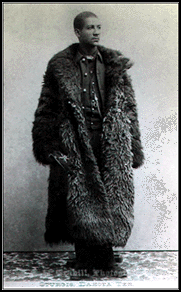 Let
us try to take a more realistic view of the documented history of the
‘Buffalo soldier’ in the American military. American Indian
people fought to hold on to their traditions, spirituality, basic economic
commissary, their land, and their lives. These were not compatible, harmonious
goals that could provide the basis for interracial harmony.
Let
us try to take a more realistic view of the documented history of the
‘Buffalo soldier’ in the American military. American Indian
people fought to hold on to their traditions, spirituality, basic economic
commissary, their land, and their lives. These were not compatible, harmonious
goals that could provide the basis for interracial harmony.
January, 1873, Camp Supply: Captain Pratt and twenty troopers of the 10th Cavalry traveled in below zero weather wearing buffalo overcoats! Their mission was to bust up ranches whose illegal business was to sell liquor, guns, and ammo to Indians, for whatever they had to trade, including stolen property such as horses, cattle and settlers personal property. They arrested the criminals and seized large quantities of rot-gut-whisky, guns, ammo, clothing and foodstuffs. Thirteen of the Buffalo Soldiers had severe frostbitten hands and feet. After a month in jail and a $10.00 fine, the American desperados were back in business. Captain Pratt left the regiment in 1874. He is now known for his work as an early educator and of the Carlisle Indian boarding school experience.
Above: January 1873 Negro Soldier, 25th Infantryman,
in buffalo overcoat. (Smithsonian image)
March, 1873, Fort Gibson, Indian Territory: Indian Agent Lawrie Tatum resigned his post, because he disagreed with the release of Kiowa Chiefs Satanta and Chief Lone Wolf. He is replaced by James Haworth, who promptly dismissed the detachment of troopers guarding the Indian Agency, believing they were not needed.

April 30, Company enroute to Fort Griffin, Texas: Troops G and
M attack Mexican horse thieves, capturing 36 men plus mules previously
stolen. One bandit and a horse were wounded.
May 1873-July, 1874; Company at Ft. Griffin, Texas having arrived there on May 12, 1873.
The explanation for the myth must be sought in the period of its emergence, rather than in the written history. Why, in the absence of data, or even despite the contrary evidence, has the myth taken hold?
The alleged bestowal of this name “Buffalo Soldiers” as a sign of respect by Indian warriors has not gone unchallenged. The most serious objection has come from contemporary Native American leaders, who were angered over the publicity attending the issue of a buffalo-soldier postage stamp in 1994 and resented the suggestion that there was some special bond between the soldiers and their warrior ancestors. In fact the 10th Cavalry's crest prominently displayed a bison, but it was designed and adopted in 1911, so while it may reflect some memory of the name dating from the regiment’s early days, it does not necessarily indicate acceptance of the name by black soldiers of the Indian-war period.
The first contemporary salvo of dissent came from Vernon Bellecourt in 2005. Writing in the weekly Indian Country Today, a reliable forum for objections to glorification of Buffalo Soldiers, Bellecourt denied that the name reflected any "endearment or respect." As far as he was concerned, Plains Indians only applied the term Buffalo Soldier to "these marauding murderous cavalry units" because of "their dark skin and texture of their hair."
The Kiowa have no
love for the historic ‘Buffalo Soldiers’. They have not forgotten
that because in those 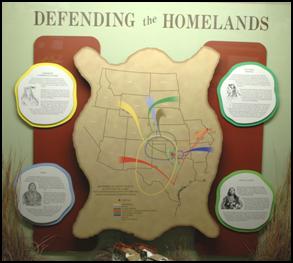 ‘Indian
War’ times there was war between the Kiowa people and their main
source of commissary the buffalo and the white men. The white men built
forts in the Kiowa country, and the Negro soldiers (the Tenth Cavalry,
made up of Negro troops) shot the buffalo as fast as they could, but the
buffalo still kept coming on, coming on, even into the post cemetery at
Fort Sill. Soldiers were not enough to hold them back.
‘Indian
War’ times there was war between the Kiowa people and their main
source of commissary the buffalo and the white men. The white men built
forts in the Kiowa country, and the Negro soldiers (the Tenth Cavalry,
made up of Negro troops) shot the buffalo as fast as they could, but the
buffalo still kept coming on, coming on, even into the post cemetery at
Fort Sill. Soldiers were not enough to hold them back.
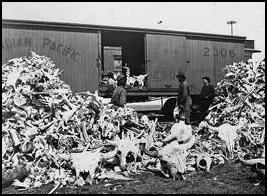 Then
the white men hired hunters to do nothing but kill the buffalo. Up and
down the plains those men ranged, shooting sometimes as many as a hundred
buffalo a day. Behind them came the skinners with their wagons. They piled
the hides and bones into the wagons until they were full, and then took
their loads to the new railroad stations that were being built, to be
shipped east to the market. Sometimes there would be a pile of bones as
high as a man, stretching a mile along the railroad track.
Then
the white men hired hunters to do nothing but kill the buffalo. Up and
down the plains those men ranged, shooting sometimes as many as a hundred
buffalo a day. Behind them came the skinners with their wagons. They piled
the hides and bones into the wagons until they were full, and then took
their loads to the new railroad stations that were being built, to be
shipped east to the market. Sometimes there would be a pile of bones as
high as a man, stretching a mile along the railroad track.
The Comanche view of the cavalry:
The Texas tradition of violence and audacity, and the perceived swagger that so often infuriates the rest of the world, stems from the fierceness of Comanche resistance to white settlement.
Most young Texans are taught to revere their frontier ancestors for what they overcame, built, and subdued through violence, doggedness and resourcefulness. After exterminating the coastal Karankawas in less than three decades, and displacing the Caddo, Tonkawa, Lipan, and Wichita, Anglo-Texans encountered along the eastern edge of the Great Plains warriors whose ancestors had thwarted Spanish imperial designs in Texas for more than a century.
By 1823, when Stephen F. Austin founded the first Anglo colony in the Mexican state of Coahuila and Texas it was very different and small by comparison.
Comanche land, Comanchería, extended from the Arkansas River in Kansas Territory, south to the Balcones Escarpment just north of San Antonio, Texas, and from present-day Fort Worth, west to the foothills of the Rocky Mountains. The Comanche were secure as few other Native Americans had ever been. Innumerable bison provided an unending source of food, clothing, and shelter. The province of New Mexico held a ready supply of horses for the taking. Comanche horse herds swelled to tens of thousands and traders out of New Mexico—Comancheros—were eager to trade guns, ammunition, knives, and needles for buffalo hides.
Comanche raiders struck deep into Mexico with virtual impunity. Pursued, they simply evaporated on the arid plains.
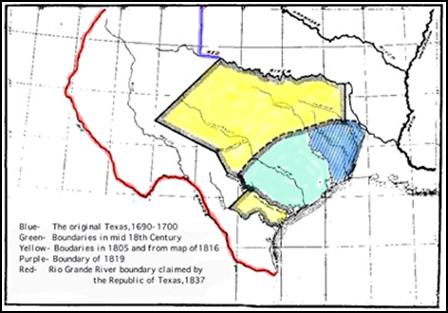 And
for some fifty years after the founding of Austin’s colony, the Comanche
barrier held Anglo-Texan expansion in check as surely as any mountain
range.
And
for some fifty years after the founding of Austin’s colony, the Comanche
barrier held Anglo-Texan expansion in check as surely as any mountain
range.
A summer of concerted Comanche raiding could drive the settlement line back as far as one hundred miles—a state of affairs previously unknown, terrifying, and galling to a burgeoning population quite sure of its place in the world and its favor in the eyes of God. This was sovereign Comanche land from time immemorial.
Though the Comanche fought invaders and competing tribes in Kansas and what would become Oklahoma, and ranchers and soldiers in New Mexico, they waged their bloodiest war with the Texans, who pursued and retaliated with murderous determination.
The Comanche and their Kiowa, Southern Cheyenne, Lipan Apache and Kiowa-Apache allies were skirmishers and long-distance raiders. The Texans, and, later, the U.S. Army, were campaigners. They waged genocidal and scorched earth economic wars not so much out of revenge or punishment but as to wear down, break, and expel the tribes.
In 1845, per Texas’s annexation agreement with the United States, all “unoccupied” land became the property of the state. Since the Comanche were not citizens of Texas, the reasoning went, and therefore they were trespassers and should be militarily expelled forthwith. This is the same illogical mentality that kept American Indian Tribal people from being recognized as citizens until 1924 and ratified by the western states till 1948.
ON SEPTEMBER 27, 1874, Tonkawa scouts, under the command of Colonel Ranald
Slidell Mackenzie, peered into a giant crevice in the High Plains that
would come to be known as Palo Duro Canyon. Below them, Comanche, Kiowa,
and Cheyenne lodges lined the canyon floor for miles and hundreds of their
horses grazed the curing grass.
Mackenzie’s Fourth Cavalry struck the next morning at dawn, stampeding the Indians’ horses. The surprised warriors put up fierce resistance while their women and children escaped.
Mackenzie’s force killed only three warriors but he now had over eleven hundred horses and mules, hundreds of lodges, and the Indians’ winter food cache. Rather than pursue, the ever-pragmatic Mackenzie drove the horses and mules twenty miles south into Tule Canyon. There, he allowed his scouts to select a few horses; the rest were driven up a long draw and shot by cavalrymen.
The Southern Plains’ finest horsemen: Comanche, Kiowa and Cheyenne were now afoot without food or shelter.
The Buffalo Soldiers of the Ninth and Tenth Cavalry harried the scattered bands throughout the fall, winter, and spring, skirmishing, burning lodges and food caches. But the Comanche held out, hunting on foot, eating grubs and rodents.
Finally, in the spring and summer of 1875, the Comanche chiefs gathered their starving people and surrendered at Fort Sill, in Indian Territory.
On the other side, it is worth noting, at the time and later, black soldiers writing in pension requests and veterans’ newspapers showed no signs of a special regard for the Indians. They used the same dismissive epithets--"hostile tribes,""naked savages,"and "redskins"—and the same racist caricatures employed by whites. Most recently we saw the same mentality and terminology used in the hunt for Osama Bin Laudin: Geronimo. Reminiscent of the use among whites of "blackface" to denigrate and stereotype African-Americans, a black private named Robinson went to a masquerade ball at Fort Bayard, New Mexico, in 1894, dressed as "an idiotic Indian squaw," according to a published report by a fellow soldier.
By the same token, it should not be too surprising to read of a black soldier calling a Plains Indian in 1890 "a voodoo nigger," repeating the voice of a white soldier who called the Plains Indians in 1873 "red niggers." This buffalo soldier only reflected the overall values of the culture in which he struggled for a place, hoping to ally himself with the dominant American group. As historian William Gwaltney, a descendent of buffalo soldiers, said, "Buffalo Soldiers fought for recognition as citizens in a racist country and...American Indian people fought to hold on to their traditions, their land, and their lives." These were not compatible, harmonious goals that could provide the basis for interracial harmony.
The idea that the buffalo-soldier combat record surpassed that of other units helps support the notion that the Indians might have been especially respectful of the black soldiers. However, it fails to withstand analysis. These soldiers did participate in significant battles. They fought in major wars against Indians, including conflicts against the Cheyenne in Kansas after the Civil War, the decade-long and brutal Apache war of the late 1870s and early 1880s, and the last major campaign, Massacre at Wounded Knee, on the Pine Ridge in South Dakota during 1890-1891.
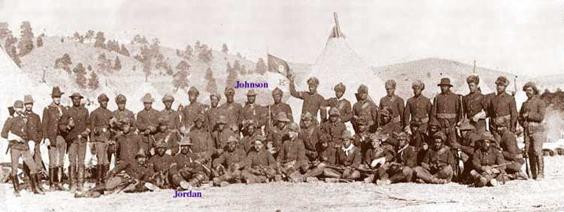
Wounded Knee massacre
site and the invasion military of the Great Sioux Nation:
9th Cavalry H troop K Company at Pine Ridge, South Dakota 1890-91.
(Note: 2 MOH recipients are named.)
Depending on which of three overlapping listings of combat engagements you choose, in the years between 1866 and 1897 they fought in between 135 and 163 of 939 to 1,282 battles and skirmishes. A consolidated count, incorporating all the engagements mentioned at least once in the three lists yields 168 encounters in which black soldiers participated, out of a total of 1,296, or 13 percent of all engagements, just about proportional to their numerical presence in the Army. This was enough to show their active participation in more than thirty years of bloody and occasionally severe combat but does not support claims that they bore the brunt of frontier warfare.
However, the Seminole-Negro scouts did serve the military courageously. They never numbered more than fifty men at a time, yet the Seminole-Negro Indian Scouts distinguished themselves. Four of the scouts received the Medal of Honor. Adam Paine earned the Medal of Honor for "gallantry in action" on the Staked Plains in the Battle of Canyon Blanco in 1874. John Ward, Pompey Factor, and Isaac Payne were also awarded the Medal of Honor for their heroic rescue of their commander, Lieutenant Bullis in an expedition against Kiowa and Comanche in 1875; while Factor and Payne provided cover, Ward rode back into a volley of fire to rescue Bullis who had become separated from his mount. The Seminole-Negro Indian Scouts received harsh treatment from Texan civilians as well as Washington DC politicians. In spite of this, they maintained a high level of effectiveness. They were loyal to the army in which they served and were proud of themselves. In the summer of 1914, the U.S. Army disbanded the scouts. At the same time, they were ordered to leave their settlement on Las Mores Creek and the grounds of Fort Clark, Texas. Without jobs or a place to go, they purchased a small piece of land near Fort Clark. This is where most of the group settled and where many of their descendants reside today.
On the popular mythical level, General Colin Powell’s highly publicized dedication of the buffalo soldier statue at Fort Leavenworth, Kansas, in the summer of 1992, made the buffalo soldier into a well-known, widely familiar cultural icon, adorning tee shirts, refrigerator magnets, phone cards, jigsaw puzzles, and coffee mugs. Buffalo soldiers also became the subjects of western novels, children's books, plays, movies, and popular songs. By the turn of the 21st century, there were also statues of black frontier-era soldiers at five western posts, most recently one dedicated at Francis E. Warren Air Force Base, in 2007, with two more soon to come. These are not manifestations of an untold story, but of one that is embedded in the popular culture.
Sources:
For more about the buffalo soldiers, their service and
their lives: Frank ‘Mickey’ Schubert, Independent Historian:
William H. Leckie, The Buffalo Soldiers: A Narrative of the Negro Cavalry
in the West (Norman: University of Oklahoma Press, 1967); Frank N. Schubert,
Voices of the Buffalo Soldier: Records, Reports, and Recollections of
Military Life and Service in the West (Albuquerque: University of New
Mexico Press, 2003); Frank N. Schubert, Black Valor: Buffalo Soldiers
and the Medal of Honor, 1870-1898 (Wilmington, DE: Scholarly Resources,
1997); and William A. Dobak and Thomas D. Phillips, The Black Regulars,
1866-1898 (Norman: University of Oklahoma Press, 2001).